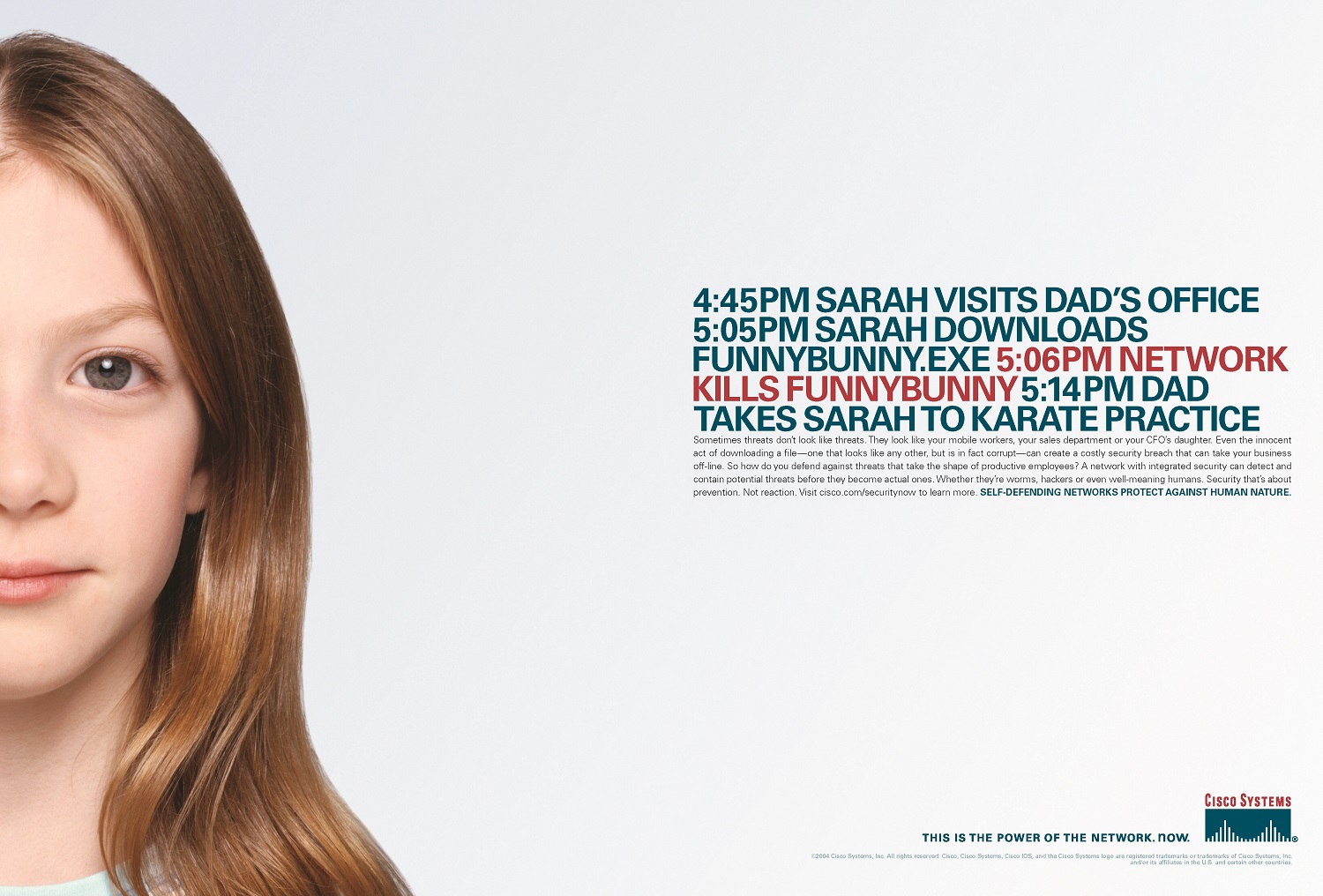American Express is a global, diversified financial services company headquartered in New York. The company is over 150 years old, founded in 1850. It is best known for its credit card, charge card, and travelers check business, but has numerous ancillary operations that are profit centers. On of the key factors in the improvement of American Express in the market is the continual thrust of its brand. Beginning in the 1960s American Express distinguished itself for two decades with several highly acclaimed campaigns. Advertising Age included two 1970s American Express campaigns (‘‘Do You Know Me?’’ and ‘‘Don’t Leave Home without It’’ featuring Karl Malden) on its list of the ‘‘50 Best Commercials.’’… Read the rest
Marketing Case Studies
Case Study: Cisco “Self-Defending Network” Ad Campaign
Besides being one of the NASDAQ’s fastest-growing stocks during the late 1990s, Cisco was also the world’s leading producer of switches and routers that directed traffic across the Internet. In 1998 Cisco released advertising that encouraged Internet usage, which in turn increased the demand for Cisco’s hardware. Two years later Cisco’s ad agency, Hill, Holliday, Connors, Cosmopulos, Inc., introduced a $43.8 million campaign with the tagline ‘‘Empowering the Internet generation.’’ The campaign’s television spots, including one titled ‘‘Factory,’’ featured Cisco’s hardware increasing businesses internet usage, which indirectly boosted the businesses profits. After the technology sector plummeted in late 2000, Cisco did not release a campaign for almost three years.… Read the rest
Case Study: Success of Amazon’s Kindle Fire
In 2007 Amazon introduced the first Kindle e-reader for $359, their first foray into selling a tangible product under their own brand. The media quickly named the product an e-reader, a limited use mobile device designed for downloading and storing content from online. Perpetuating a successful, yet deceptively simple business model, the Kindle e-reader made “online [book] shopping so easy and convenient,” customers could browse, download and read books, magazines and newspaper content, at the click of a button on the Kindle. The e-reader market perked up as Amazon offered an affordable price point of $9.99 for book downloads and blended it with an easy to read e-ink, glare free device along with a simple user interface and operating system.… Read the rest
Case Study: Apple iMac Ad Campaign
In the late 1990s technology analysts speculated that Apple Computer, Inc.’s fate hinged on its new personal computer the iMac. Apple’s share of the worldwide desktop-computer market had plummeted since 1995, the last year the company had been profitable. Ever greater numbers of consumers were buying personal computers (PCs) that ran on Microsoft’s Windows operating system rather than Apple’s version. Although Apple had pioneered user-friendly computers, the company had not introduced a consumer-targeted computer since 1992. Hoping that its stylish new iMac would propel Apple back into this vast segment of the market, Apple released its iMac ad campaign.
The iMac ad campaign consists of a series of seven television commercials.… Read the rest
Case Study: Apple iPod Silhouette Ad Campaign
Released by Apple Computer, Inc., in November 2001, the iPod rapidly grew in sales and by 2005 had become the world’s top-selling MP3 player. With a 1,000-song capacity, the first iPod worked only with Apple computers and retailed at $400. From 2003 to 2005, however, Apple ferociously promoted five new Windows-compatible iPod models, along with the company’s digital music store, iTunes. In an attempt to define the fun associated with the iPod brand and to steer advertising away from the Apple computer, the company released its ‘‘Silhouette’’ campaign.
In October 2003 ad agency TBWA\Chiat\Day (TBWA\C\D) introduced outdoor ‘‘Silhouette’’ ads in Los Angeles, followed by a nationwide print and television launch.… Read the rest
Case Study: Apple Switch Ad Campaign
By June 2002, after 18 months of new products that included the eMac, OS X operating system, G4 processor, iPod, and new flat-screen monitor, Apple Computer, Inc., still held only 5 percent of the U.S. market and between 2 and 3 percent of the worldwide market in personal computers. Apple’s proprietary lock on technology in the 1980s had forced hardware manufacturers like Dell, Gateway, and Compaq to avoid Apple software and to ship their PCs with Microsoft’s operating system. Apple isolated itself from the masses even more with its 1997 ‘‘Think Different’’ campaign, which associated the brand with revolutionary figures like Mahatma Gandhi and John Lennon.… Read the rest





